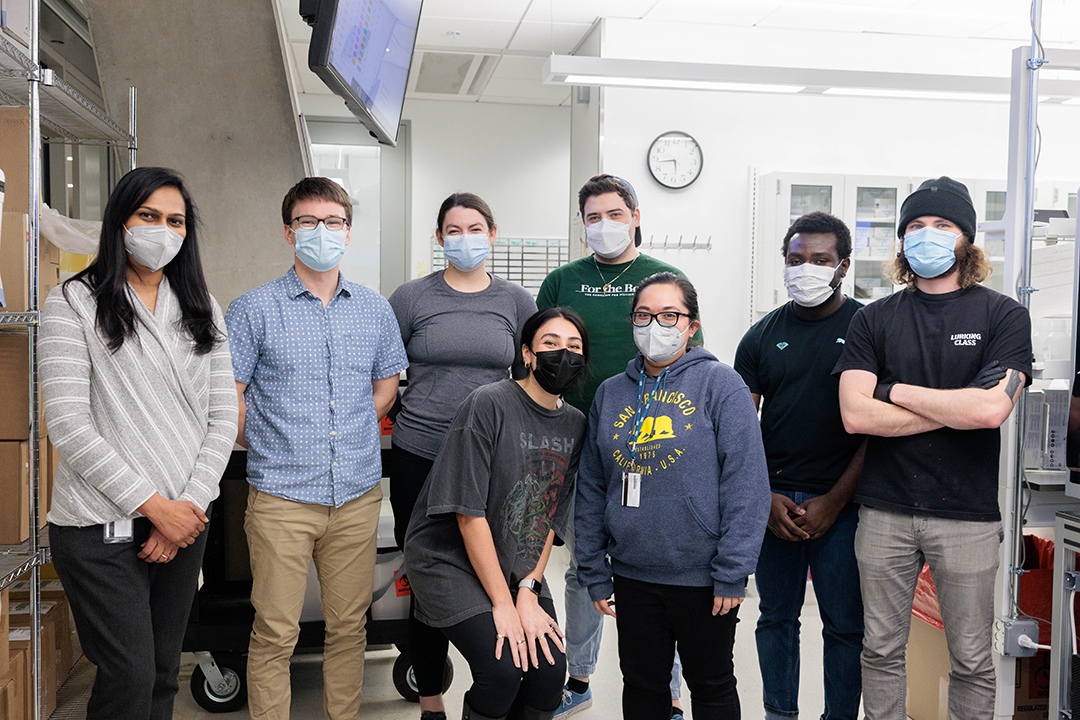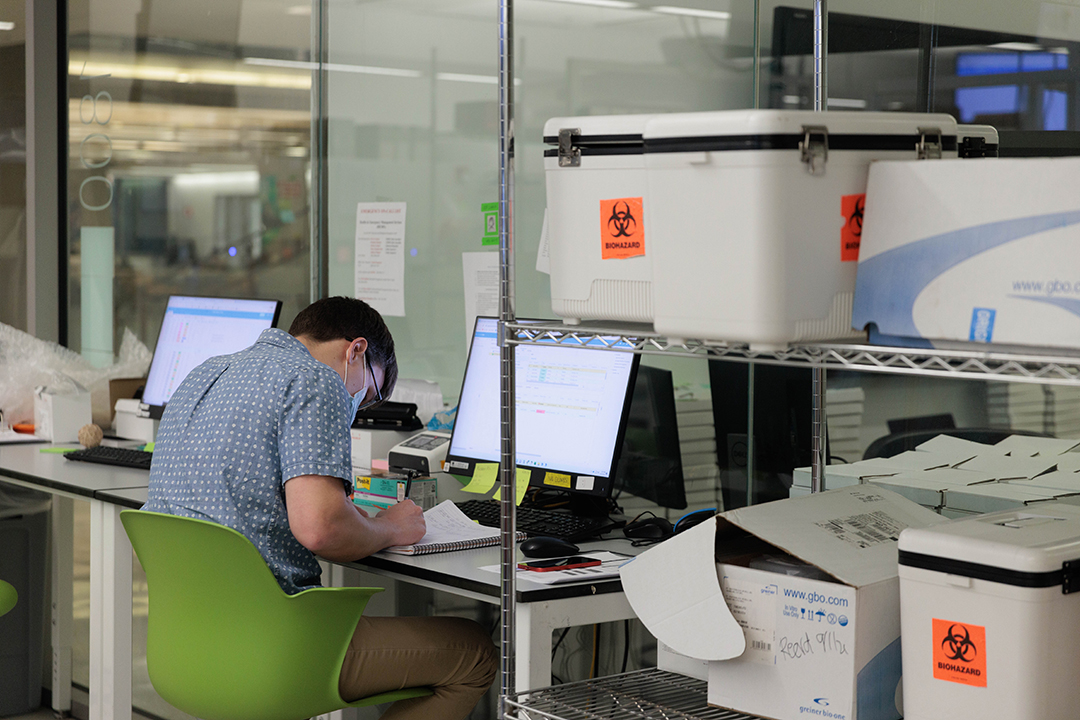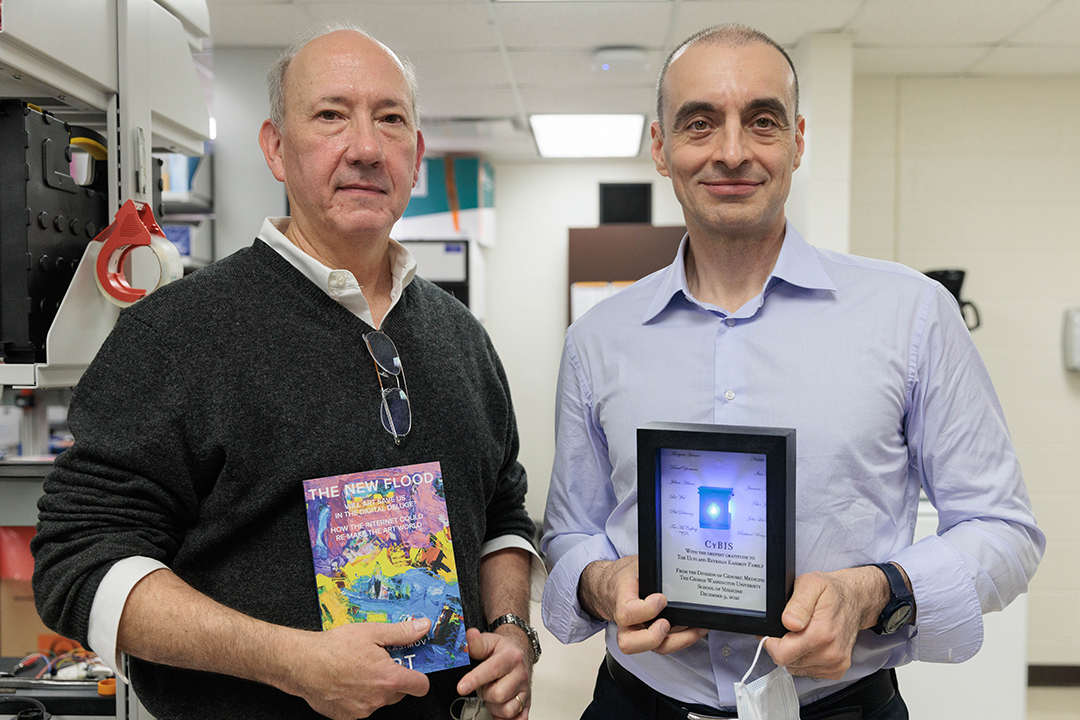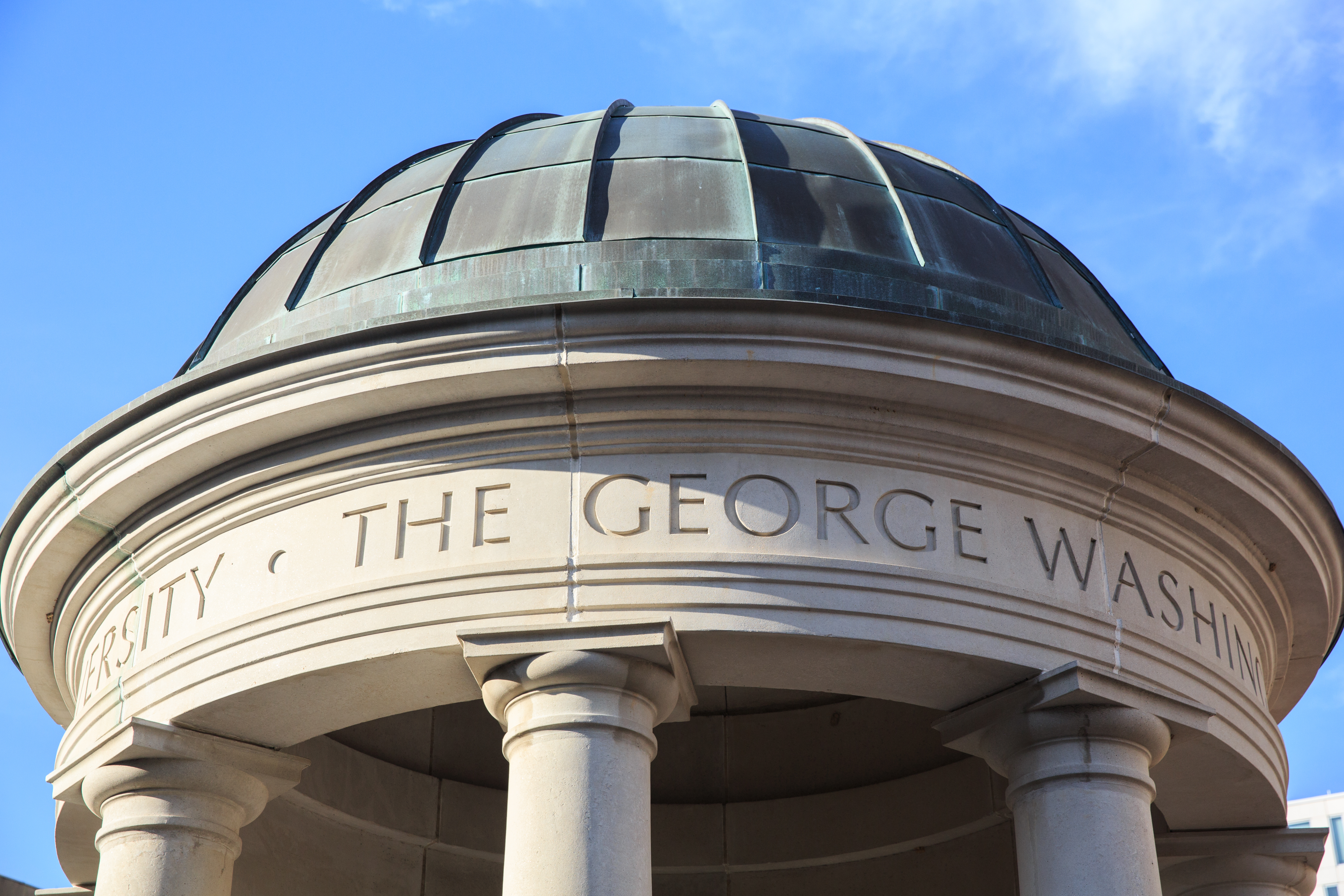By Kristen Mitchell
Have you ever thought about what happens to your COVID-19 test after you hand off your nasal swab at one of George Washington University’s testing centers? Since beginning operations in August 2020, the GW Public Health Lab has processed nearly 400,000 PCR tests to ensure the safety of the university community.
The GW Public Health Lab, which operates on the first floor of Science and Engineering Hall, processes COVID-19 tests for approximately 25,252 members of the on-campus community— individuals who are required to take part in the regular testing protocol as a condition of access to campus. This testing protocol enabled the university to bring students, faculty and staff back to campus for in-person activities at the start of this academic year.
From test processing and sample extraction to the actual molecular PCR testing and data analysis, a team of laboratory professionals work behind the scenes to ensure the safety of the GW community. Over the past year and a half, the team has increased use of automation, improved workflow procedures and managed supply chain challenges to ultimately develop a system that allows for the daily processing of more than 3,000 samples.
“People might think you put the swab in the nose and then maybe it's put in an instrument and the results pop up, but there are so many steps from the time the swab arrives in the lab to the time the results are out,” said Praveena Tummala, technical director of laboratory operations. “We're constantly working on the workflow, making it more lean. Before it was mostly manual, but automation has helped us increase accuracy as well as improve the turnaround time.”
The lab is managed by Tummala, Laboratory Manager Jack Villani and Medical Director Jorge Sepulveda, a professor in the SMHS Department of Pathology. The lab resulted from a joint effort between the Milken Institute School of Public Health, GW Medical Faculty Associates and GW School of Medicine and Health Sciences.
Here is what happens to your nasal swab after you collect your sample and drop it off:
Bagged tests are packed into chilled biohazard containers for safe transportation to the GW Public Health Lab. The lab receives new samples from the Foggy Bottom asymptomatic and symptomatic testing locations several times a day. The lab also receives samples from the Virginia Science and Technology campus and GW testing sites in Arlington, Alexandria and Rockville multiple times a week. The lab staff prioritizes processing symptomatic tests first to ensure results are available to patients as fast as possible.
Once the bagged samples are ready to be processed, laboratory staff removes them from the biohazard containers and commences the intake process—a visual inspection to ensure every sample includes a nasal swab and is properly identified and sealed. From this point, it will take about six hours of procedural time for PCR testing to be complete.
After the samples are checked, they go into the lab’s processing room, which has enhanced biosafety procedures for the protection of lab staff. Inside this room, staff prepares the samples for batch processing, to process a greater volume of samples simultaneously. Staff removes the samples from the bags and dispose of the swabs as biohazard waste before transferring the liquid contents of the tube into 96-well plates, each holding 91 samples and 5 extraction controls, for testing—systematically correlating which samples are going where to ensure results are reported accurately.
In the processing room, samples are also combined with a chemically inactivating buffer that inactivates many viruses, ensuring that nothing leaving the room poses a threat to lab staff. The sample tubes are heat inactivated, stored for up to a week in case retesting is necessary, and then discarded as biological waste.
Next the plates are taken out of the processing room for extraction. Before the samples can be tested for COVID-19, the lab has to purify any human or viral RNA that is present. RNA plays a significant role in passing information about protein structure between cells. The lab does this using liquid-handling robots to break down any cells and viral particles present in the sample. The extraction procedure on the robots preserves RNA needed for testing and washes away anything else that could contaminate the sample, leaving only purified RNA behind.

Members of the GW Public Health Lab team. (William Atkins/ GW Today)
To conduct the analysis the lab uses PCR (polymerase chain reaction) technology to amplify small amounts of RNA from specimens into deoxyribonucleic acid (DNA), which is replicated until SARS-CoV-2 is detectable if present. Using a machine, the samples of purified RNA are combined with a pre-prepared “master mix,” which includes everything needed to prompt a PCR reaction except for the sample itself. The lab staff creates a batch of this mix every three hours or so as needed. From here, the samples are ready for PCR testing.
The PCR-testing instrument is programmed to test for two SARS-CoV-2 viral gene targets and one human gene target. The human gene target acts as an internal control to make sure there is a sufficient specimen present; if not the lab team has low confidence that a result is valid. During testing, the instrument amplifies the gene targets using 40 cycles of heating and cooling and shines a laser into each sample on the well plate each cycle. Samples will fluoresce, or light up, when sufficient COVID-19 RNA has been amplified. The instrument measures how brightly and at which cycle of amplification individual samples light up, forming the basis for a determination of whether a viral test is positive or negative. If only one of the viral targets is amplified the result is labeled as inconclusive—however, for practical purposes the lab team considers that COVID-19 viral RNA is present and individuals should behave as if positive. Invalid results mean no sufficient human RNA was detected and samples are flagged to either be processed again or to advise individuals to seek retesting.
Following completion of PCR testing, the data is reviewed by the lab team to assess any discrepancies and approve the results for release to the medical portal. This is typically within 24 to 36 hours of the initial nasal swab arriving in the lab
The laboratory has a sophisticated laboratory information management system that facilitates management of workflows but also passing results to others who need them. All results are forwarded to the relevant clinicians in the student or employee health services at GW for any needed medical follow up, as well as Campus COVID Support Team (CCST) for support including gathering information about on campus contacts.
No later than 48 hours after the results are produced, the CCST transfers all positive and negative results to GW’s Business Intelligence group for inclusion in the next update to the GW Coronavirus Dashboard. Per law, all results also are provided to the health departments in Washington, D.C., or Virginia, and they in turn report the results to the Centers for Disease Control and Prevention.





